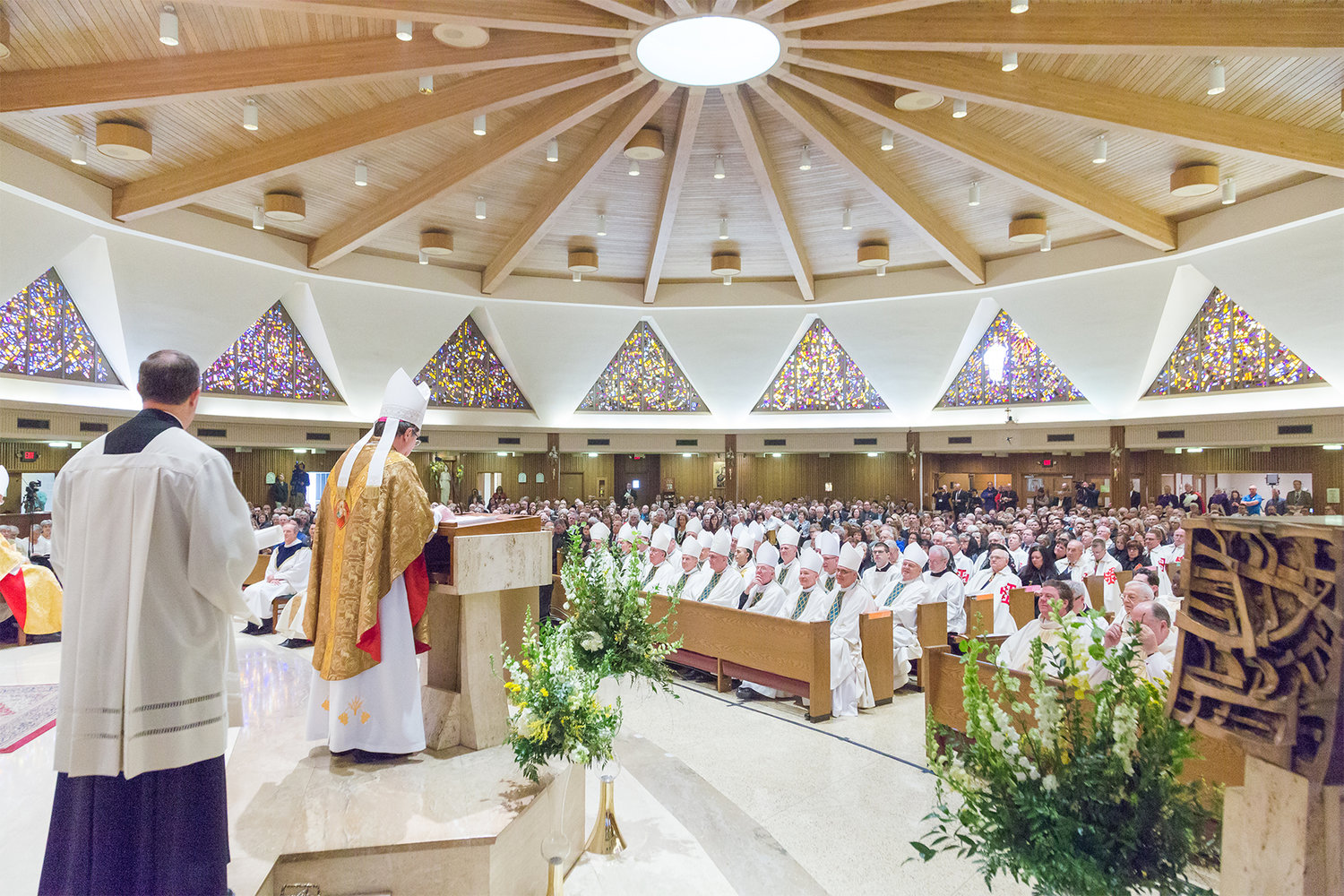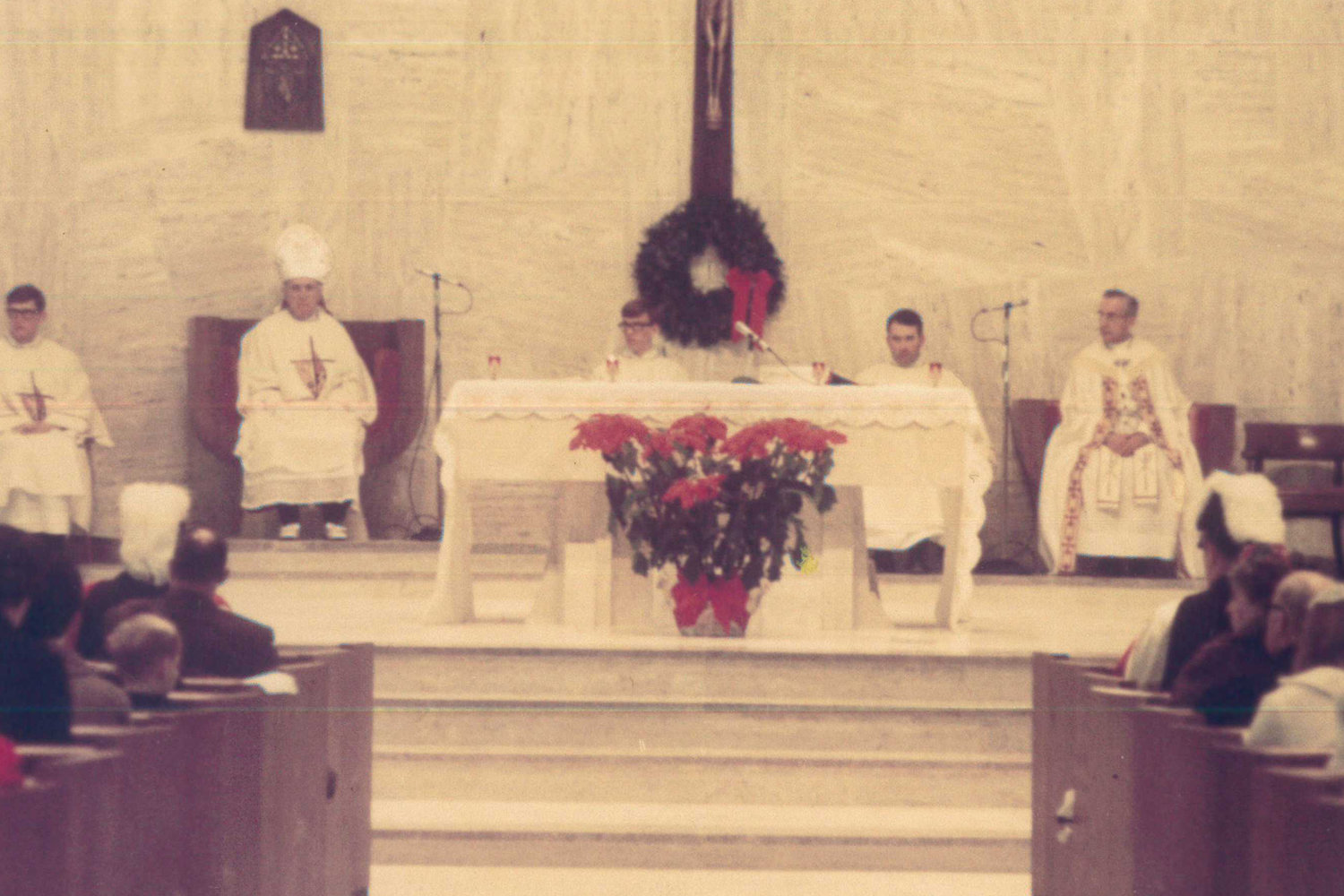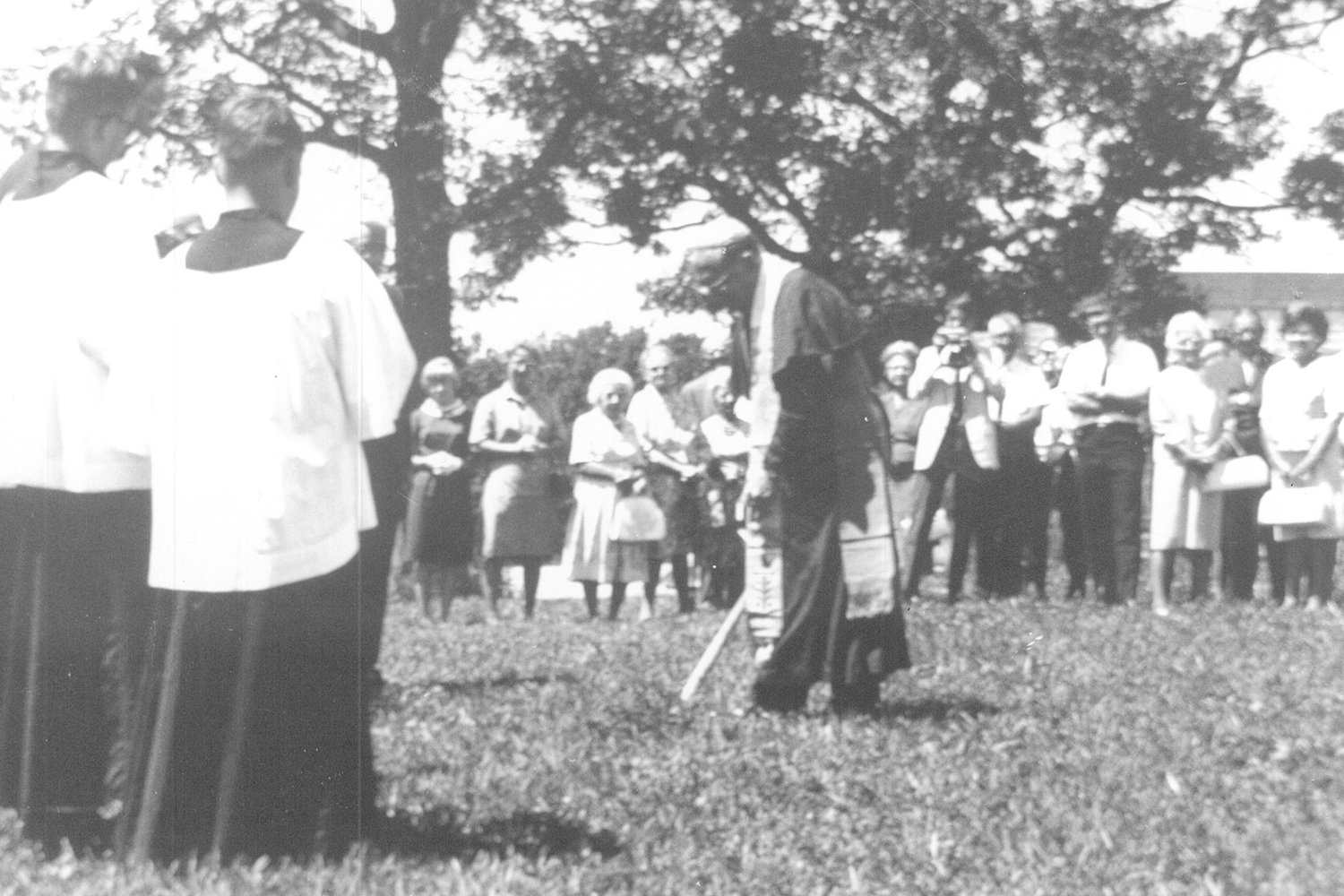Bishop McKnight’s first Christmas Mass here will mark half-century for Cathedral of St. Joseph

At Midnight, the doors swung wide-open, hymns spilled out into the churchyard and Bishop Joseph M. Marling C.PP.S. entered the Cathedral of St. Joseph to offer Mass there for the first time.
Joining him in the procession was a young altar server named John Schwartze.
Directing the choir was Bob Rackers, accompanied by his wife Mary on the splendid new organ.
Fifty years later, Deacon Bob Rackers and Deacon John Schwartze will assist Bishop W. Shawn McKnight at Mass on Christmas Eve in the cathedral.
“In 50 years, we’ve come full circle,” said Deacon Rackers. “I can’t think of another time you’ve had two people at the first Mass in a cathedral be able to assist the bishop there as ordained ministers a half-century later.”
The Mass, which will start at 9 p.m., will mark Bishop McKnight’s 51st Christmas and his first as ordinary of the Jefferson City diocese.
“The people who come in and go out of our cathedral have changed over the years, but it is the same building, the same faith that always draws them here,” the bishop said.
The first cathedral
St. Peter Church, an impressive, 1882-vintage edifice near the State Capitol, had been serving as the cathedral for the diocese since its creation in 1956.
St. Joseph parish had been founded in 1958 to serve western Jefferson City’s growing Catholic population.
By 1966, St. Joseph parish had outgrown its temporary church inside the parish school.
The pastor, Monsignor Gerard L. Poelker, now deceased, sought permission to build a permanent church with room for everybody.
Bishop Marling had something even more substantial in mind.
While returning from his first ad limina visit to Pope St. John XXIII in Rome, he stopped in Switzerland, where he visited a large, modern, circular church building.
Bishop Marling asked Father Fred Barnett, who was traveling with him, “What do you think of this?”
“I like it,” the priest replied.
“I want a cathedral like this,” said Bishop Marling.
Reverent yet modern, open and full of light, it reflected in many ways the optimism of the post-War Church and many of the ideals that would be articulated at the Second Vatican Council.
For the parish and diocese
Msgr. Poelker met with about 200 parishioners on March 2, 1966, to discuss a proposal to build a church and look at preliminary drawings.
“However, it would be more than a year before plans were finalized and contracts were let and ground was broken,” Deacon Rackers wrote in a history of the parish.
He noted that the original plans did not call for a basement. But parishioners with construction backgrounds pointed out that the topography was ideal for a lower level with a separate entrance.
The pastor agreed.
Bishop Marling wrote to Msgr. Poelker on Nov. 28, 1966, that the new church should be constructed with both the parish and the diocese in mind.
Final plans called for unobstructed seating for 1,000 people, with parking spaces for 400 cars.
The spacious, circular nave and elevated sanctuary were designed especially for liturgical functions at which a bishop would preside, with adequate space for processions and to accommodate dozens of concelebrating priests.
There would be no stairs leading up to the main entrance.
The choir would be seated near the organ to the right of the sanctuary, rather than in a loft.
Bishop Marling made it clear that the diocese would share in the estimated $1.2 million cost of the new cathedral (about $8.7 million in today’s dollars).
A groundbreaking ceremony was held on Aug. 20, 1967, on what had been a baseball field for schoolchildren.
Assisting the bishop were Msgr. Poelker and Monsignor Joseph A. Vogelweid P.A., pastor of what was known at that time as the Cathedral of St. Peter.
“A procession was formed at the church/school building; and, led by servers carrying a cross, holy water and a shovel,” Deacon Rackers wrote.
After communal prayer and the proclamation of Scripture, the bishop blessed the ground.
He and the two priests then took turns ceremonially turning over shovelfuls of dirt.
Crowning achievement
Parishioner Jay Prost, whose company had built the nearby Carmelite Monastery and other buildings in the diocese, bid on the cathedral project and was chosen to be the general contractor.
Footings were poured in early October, with the hope of construction continuing through the winter.
The cathedral was to be built of reinforced concrete and steel, with an exterior faced with Indiana limestone and a crown-shaped roof of wood and copper, supported by Douglas fir beams radiating from the center.
The circular floorplan was to be 157 feet in diameter, with a height of 72 feet from the floor to the apex of the spire.
“From the top of the roof to the top of the cross, the spire rises 29 feet,” Deacon Rackers noted.
When completed, the cathedral would bear a striking resemblance to the chapel of the Vatican Pavilion at the 1964-65 World’s Fair in New York.
These stones will cry out
The back wall of the sanctuary was to be adorned with a pattern of intricately cut slabs of Travertine marble.
Msgr. Poelker hired an experienced artisan from St. Louis named Joe Cluck to cut and install the stonework.
As the scope of the project became evident, Msgr. Poelker asked parishioner Larry Poetker, who was the sexton at Resurrection Cemetery, to help Mr. Cluck cut the marble, fit it and attach it to the wall.
Afterward, Mr. Poetker and parishioner Frank Cernic used the leftover marble to build a matching altar for the chapel, and a credence table.
The main cathedral altar weighs 7,000 pounds.
Travertine marble statues placed throughout the cathedral — including St. Joseph, the Blessed Mother and the Sacred Heart — as well as the hand-carved Stations of the Cross, came from Italy.
Three Italian mosaics depict the Infant Jesus of Prague, Our Lady of Perpetual Help, and St. Ann, grandmother of Jesus.
The kaleidoscopic stained-glass windows splash waves of color across the interior, especially in the morning and late afternoon.
An imposing stained-glass image of Christ in risen glory filters sunlight onto parishioners exiting the cathedral at the end of Mass.
The faceted glass windows in the chapel symbolize five functions of a priest: the tools of St. Joseph, patron of priests; blessing marriages; teaching; preaching the Gospel; and conducting Christian burials.
One hundred sixty employees of the Wicks Organ Company of Highland, Illinois, had a hand in building the three-manual organ.
It contains 1,758 pipes made of wood and metal, ranging in length from a few inches to 16 feet.
“Joy to the World”
Everything was in place in time for Christmas.
Deacon Rackers recalled that the lights came on as the master of ceremonies, priests and servers began to make the final preparations for Midnight Mass.
“The nearly 30,000 watts of lights were much brighter than many expected,” he recalled.
Mary Rackers recalled that during preparations, a mouse was spotted scurrying around the sanctuary amidst the poinsettias.
Finally, the doors were opened and the people began taking their places in the modern pews upholstered with bronze-colored fabric.
Nearly 100 poinsettias adorned the altar.
“The contrast of the red blooms and the white marble was so vivid that it was difficult to look away and see the rest of the interior of the church,” Deacon Rackers recalled.
At 11:30 p.m., the choir began a 30-minute program of Christmas hymns.
“At precisely midnight,” Deacon Rackers wrote, “a server ... carrying a thurible of incense, began to walk down the aisle, followed by a server with the Cross and servers with candles.”
Msgr. Poelker and Bishop Marling followed.
The bishop and priest bowed and ascended the steps to reverence the altar.
After a blessing, Bishop Marling began incensing the altar, first at the rear facing the people, then moving to the east and around the altar to the front.
He then chanted a prayer of blessing for the new church as he moved to the cathedra — the bishop’s chair that is the symbol of his teaching authority.
His homily included a welcome to all who were present and were to be regular worshippers of God in this new church.
At the recessional, the choir and congregants sang out, “Joy to the World!”
Two days later, Bishop Marling notified the Vatican that the new cathedral had been completed and placed into service.
What goes around ...
Deacon Schwartze remembers serving at that first Mass with Warren Prost and Barry Cunningham.
“Everything was new, including our new red cassocks with white surplices,” he said.
What he remembers most is an overwhelming sense of awe.
“Up to that point, our church was the first floor of our two-story school building,” he said. “To go from that to the newness and enormity of the cathedral, with all the richness of the ritual, was just incredible.”
A few months after Bishop Marling’s first Mass in the cathedral, Deacon Schwartze got to serve at the first Mass Bishop Michael F. McAuliffe, the diocese’s second bishop, celebrated there.
Since then, as a deacon, he has gotten to assist at Masses offered in the cathedral by Bishop Emeritus John R. Gaydos and Bishop McKnight.
Deacon Schwartze and his wife Carol lived away from Jefferson City for 31 years before returning in 2015.
He’s quick to point out to young people learning how to be altar servers what an honor it is to serve at the cathedral: “They will experience Liturgies and the frequency of serving with the bishop that will be very meaningful to them throughout their lives.”
He said he’s most grateful to be able to minister as a deacon in the parish where he was raised, and to assist at the 50th-anniversary Mass.
“My wife calls this my ‘Simba moment,’” he said, referring to a character in Walt Disney’s animated “The Lion King” whose song is “The Circle of Life.”
Holy ground
In the five decades since the cathedral-proper and its downstairs undercroft were completed, they have given shelter to countless diocesan functions, including ordinations, bishops’ installations, Chrism Masses and funerals.
They have also been the site for even more baptisms, weddings, confirmations, funerals, graduations and other parish and school functions.
The parish is now in the preliminary stages of planning for repairs and updates to help ensure and enhance the cathedral’s functionality as mother church for the diocese and spiritual home for the parish’s 1,400 households.
Comments
Other items that may interest you
Services
The Catholic
Missourian
2207 W. Main St.
Jefferson City MO 65109-0914
(573) 635-9127
editor@diojeffcity.org









